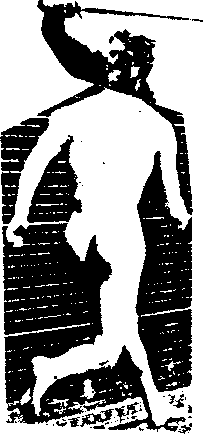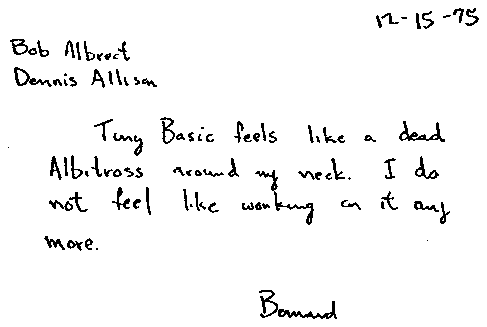 dr.
dobbs journal of
dr.
dobbs journal of dr.
dobbs journal of
dr.
dobbs journal of| Box 310, Menlo Park CA 94025 | Volume 1, Number 1 |
STATUS LETTER
by Dennis Allison
The magic of a good language is the ease with which a particular idea may be expressed. The assembly language of most microcomputers is very complex, very powerful, and very hard to learn. The Tiny BASIC project at PCC represents our attempt to give the hobbyist a more human-oriented language or notation with which to encode his programs. This is done at some cost in space and/or time. As memory still is relatively expensive, we have chosen to trade features for space (and time for space) where we could.
Our own implementation of Tiny BASIC has been very slow. I have provided technical direction only on a sporadic basis. The real work has been done by a number of volunteers; Bernard Greening has left the project. As might be guessed, Tiny BASIC is a tiny part of what we do regularly. (And volunteer labor is not the way to run a software project with any kind of deadline!)
While we've been slow, several others have really been fast. In this issue we publish a version of Tiny BASIC done by Dick Whipple and John Arnold in Tyler, Texas. (And other versions can't be far behind.)
MY, HOW TINY BASIC GROWED!
Once upon a time, in PCC, Tiny BASIC started out to be:
* a BASIC-like language for tiny kids, to be used for games, recreations,
and the stuff you find in elementary school math books.
* an exercise in getting people together to develop FREE software.
* portable-machine independent.
* open-ended--a toy for software tinkerers.
* small.
Then ... (fanfare!) ... along came Dick Whipple and John Arnold. They
built Tiny BASIC Extended. It works. See pp 13-17 and 19 in this issue
for more information. More next issue.
WANTED: More Tiny BASICs up and running.
WANTED: More articles for this newsletter.
WANTED: Tiny other languages. I might be able to live with Tiny FORTRAN
but, I implore you, no Tiny COBOL! How about Tiny APL? Or Tiny PASCAL (whatever
that is)?
WANTED: Entirely new, never before seen, Tiny Languages, imported from
another planet or invented here on Earth. Especially languages for kids
using home computers that talk to tvs or play music or run model trains
or ...
BASIC
BASIC, Beginners' All-purpose Symbolic Instruction Code, was initially
developed in 1963 and 1964 by Professors John Kemeny and Thomas Kurtz of
Dartmouth College, with partial support from the National Science Foundation
under the terms of Grant NSF GE 3864. For information on Dartmouth BASIC
Publications, get Publications List (TM 086) from Documents Clerk, Kiewit
Computation Center, Dartmouth College, Hanover NH 03755. Telephone 603-646-2643.
| Try these: | TMO28 BASIC: A Specification $3.15 |
| TM075 BASIC $4.50 |
DRAGON THOUGHTS
* We promised three issues. After these are done, shall we continue?
* If we do, we will change the name and include languages other than
BASIC.
* This newsletter is meant to be a sharing experience, intended to
disseminate FREE software. It's OK to charge a few bucks for tape cassettes
or paper tape or otherwise recover the cost of sharing. But please make
documentation essentially free, including annotated source code.
* If we do continue, we will have to charge about $1 per issue to recover
our costs. In Xeroxed form, we can provide about 20-24 pages per issue
of tiny eye-strain stuff. If we get big bunches of subscriptions, we'll
print it and expand the number of pages, depending on the number of subscribers.
* So, let us know... shall we continue?
For our new readers, and those who have been foilowing articles on Tiny BASIC as they appeared in People's Computer Company, we have reprinted on pages 3-12 the best of Tiny BASIC from PCC as an introduction, and as a reference.
TECHNIQUES & PRACNIQUES
by Dennis Allison, 12/1/75
(This will be a continuing column of tricks, algorithms, and other good stuff everyone needs when writing software. Contributions solicited.)
16-BIT BINARY TO DECIMAL CONVERSION ROUTINE
* saves characters on stack
* performs zero suppressed conversion
* uses multiplication by 0.1 to obtain n/10 and n mod 10
define crutch = OFFH;
declare n, u, v, t; BIT (16) These could be
registers, or on the stack
if n < 0 then
do;
n = -n;
call outch('-');
end;
call push (crutch)
The crutch marks the end of number on the stack
repeat;
v = shr (n,l);
v = v + shr (v,l);
These all are 16 bit shifts
v = v + shr (v,4);
Computes [n/10] or [n/10] - 1 by
v = v + shr (v,8);
multiplication
v = shr (v,3);
Call it x
t = v + v;
u = t + t;
Computes 10 - x
u = u + u + t;
u = n - u;
Byte only as high order must be equal
if u >= 10 then
Perhaps one could use a decimal feature here
do
u = u - 10;
n = v + 1;
Corrects for case where [n/10] - 1
end
is computed and creates [n/10] and n mod 10
else
n = v;
call push (u);
Saves result on stack
until n = 0;
Loop at least once
ch = pop;
do while < > crutch;
Write result in reverse order
call outch (ch + 030H);
Converts digits to ASCII 0 = 030H 02 = 032H etc.
ch = pop;
Pop takes one word off the stack
end
PCC Tiny BASIC Reorganizes...

... and so we procede somewhat more slowly than some of our readers
| Dennis Allison - | technical editor |
| Bob Albrecht
John Arnold Dick Whipple |
contributing
editors |
| Lois Britton -
Rhoda Horse - |
circulation manager
midwife-at-large |
* Letters from readers are most welcome. Unless they note otherwise, we will assume we are free to publish and share them.
* We hereby assign reprint rights to all who wish to use Tiny BASIC Calisthenics & Orthodontia for non-commercial purposes.
* To facilitate connection between our subscribers, we wil in subsequent issues publish our subscriber list (includin addresses and equipment of access/interest).
I want to subscribe to
* DR. DOBB'S JOURNAL OF TINY BASIC CALISTHENICS &
ORTHODONTIA *
(3 issues for $3)
NAME____________________________________
ADDRESS_________________________________
CITY______________ STATE______ ZIP_______
(If you would like us to publish your name, address, and equipment of access/interest in futirre issue(s), please indicate VERY SPECIFICALLY.
EQUIPMENT
OF ACCESS/INTEREST______________________________
__________________________________________________
Please send check or money order (purchase order minimum:
$6) to TINY BASIC CALISTHENICS & ORTHODONTIA
[ADDRESS DELETED] Thank
you.
[Links to Tiny Basic articles...]
Build Your Own Basic (reprinted from People's
Computer Company Vol. 3. No.4)
Design Notes for Tiny Basic (reprinted from
People's Computer Company Vol. 4, No. 2)
Tiny Basic letters (reprinted from People's
Computer Company Vol. 4, No. 3)
Corrected Tiny Basic IL
Jeffrey
Henning's IL implementation (2017)
Tiny Basic Extended (Dick Whipple & John Arnold)
Last two pages...